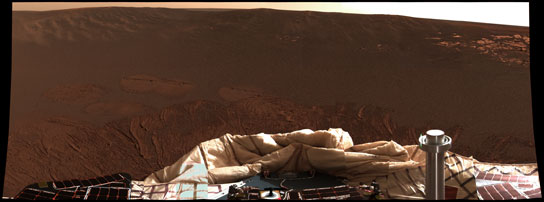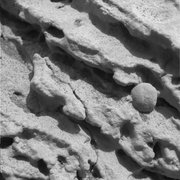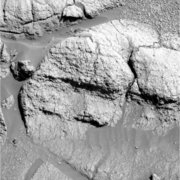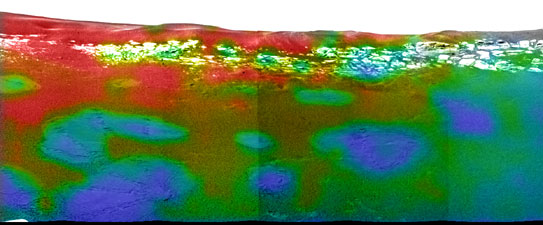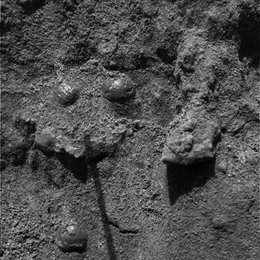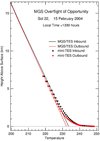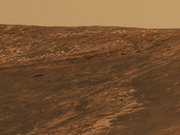Opportunity rover
|
|

| This article or section contains information about a current or ongoing event. |
| Information may change rapidly as the event progresses and may temporarily contain inaccuracies, bias, or vandalism due to a high frequency of edits. |
Opportunity (official designation: MER-B) is the second of the two rovers of NASA's Mars Exploration Rover Mission. She landed successfully on Mars on January 24, 2004 at 21:05 PST (January 25 05:05 UTC). Her twin Spirit landed on Mars three weeks earlier on January 3, 2004. (Mission members decided to reference both rovers using the feminine gender.)
Opportunity-02.gif
MERB_Map_383-540-860.jpg
Naming of Spirit and Opportunity
The Spirit and Opportunity rovers were named via a student essay competition, from a winning entry by Sofi Collis, a 9 year old 3rd grade student from Arizona.
- I used to live in an Orphanage.
- It was dark and cold and lonely.
- At night, I looked up at the sparkly sky and felt better.
- I dreamed I could fly there.
- In America, I can make all my dreams come true.....
- Thank-you for the "Spirit" and the "Opportunity"
- -Sofi Collis, age 9
See NASA Names Mars Exploration Rovers Spirit and Opportunity (http://www.planetary.org/html/news/articlearchive/headlines/2003/rovers_named.html)
PIA05229_label.jpg
Landing site: Challenger Memorial Station
Opportunity landed in Meridiani Planum at 354.4742°E 1.9483°S (areocentric coordinates), about 24 km downrange (east) of her intended target. Although Meridiani is a flat plain, without the rockfields seen at previous Mars landing sites, Opportunity rolled into Eagle crater, a small crater approximately 20 meters in diameter and it would be two weeks before she stuck a camera up to get a better look of her surroundings.
On 2004 January 28, NASA announced that the landing site was being named in honor of the seven astronauts of the final mission of space shuttle Challenger, killed 18 years ago this day when the shuttle exploded shortly after launch.
Mission duration
The primary mission for Opportunity was planned to last 90 sols. Many mission members were hopeful that they could function much longer, and on April 8, 2004, NASA announced that it would support an "extended mission" for both rovers, all the way through September 2004 with funds and manpower.
In July, 2004, mission managers started to discuss options with NASA to extend the mission even beyond the 250 days agreed to in April. If the rovers could survive the winter, it is hoped many more interesting science goals would be achievable (see BBC news (http://news.bbc.co.uk/2/hi/science/nature/3872975.stm)).
Events and discoveries
Timeline
A detailed chronology of events and discoveries may be found in the Opportunity rover timeline entry. The following paragraphs discuss the more notable findings.
First panorama
This 360-degree panorama is the first panorama beamed back to Earth from the Mars Exploration Rover Opportunity shortly after she touched down at Meridiani Planum, Mars. The image was captured by the rover's navigation camera.
First color panorama
This color image shows the martian landscape at Meridiani Planum, where the Mars Exploration Rover Opportunity successfully landed at 9:05 p.m. PST on January 24,2004. This is one of the first images beamed back to Earth from the rover shortly after she touched down. The image was captured by the rover's panoramic camera.
Opportunity lands in a crater
The interior of a crater surrounding the Opportunity at Meridiani Planum on Mars can be seen in this color image from the rover's panoramic camera. This was the darkest landing site ever visited by a spacecraft on Mars. The rim of the crater was approximately 10 meters (32 feet) from the rover. The crater is estimated to be 20 meters (65 feet) in diameter. Scientists were intrigued by the abundance of rock outcrops dispersed throughout the crater, as well as the crater's soil, which appeared to be a mixture of coarse gray grains and fine reddish grains. NASA Scientists were so excited about landing in a crater that they called the landing a "hole in one." Later, the crater was named Eagle crater.
"Opportunity Ledge" outcroppings
This sweeping look at the unusual rock outcropping near Opportunity was captured by the rover's panoramic camera. Scientists believe the seemingly layered rocks are either volcanic ash deposits or sediments laid down by wind or water. It was given the name Opportunity Ledge.
Sol3_Outcrop_Color-sol004-b-B004R1_th544.jpg
This panorama of Eagle crater shows outcroppings
Geologists said that the layers—some no thicker than a finger—indicate the rocks likely originated either from sediments carried by water or wind, or from falling volcanic ash. "We should be able to distinguish between those two hypotheses," said Dr. Andrew Knoll of Harvard University, Cambridge, a member of the science team for Opportunity and her twin, Spirit. If the rocks are sedimentary, water is a more likely source than wind, he said.
These layered rocks measure only 10 centimeters (4 inches) tall and are thought to be either volcanic ash deposits or sediments carried by water or wind. The layers are very thin measuring just a few millimeters thick in some cases.
On Sol 15, Opportunity took a close up of the rock Stone Mountain in the outcrop area of the crater.
From this picture it was speculated, that it does consist of very fine grain or dust. This is in contrast to Sandstone on Earth, which is compacted sand with rather large grains. Also, the weathering agent eroding away layers of this rock seems to be visible (dark spots).
"Embedded in it like blueberries in a muffin are these little spherical grains," said Dr. Steve Squyres of Cornell University, Ithaca, N.Y., principal investigator for the rovers' scientific instruments. He also said: "One other teasure, a clue that just popped up, not gonna quote any numbers yet, but we have now completed an APXS measurement on the outcrop and it has got a lot of sulfur in it. Maybe a few times more sulfur than we've seen on any other location on Mars."
A picture received on February 10 (and taken on Sol 16) had mission scientists excited. It showed that the thin layers in the bedrock are not always parallel. Instead, if you look closely at this image from an angle, you will notice that the lines converge and diverge at low angles. These unparallel lines give unparalleled clues that some "moving current" such as volcanic flow, wind, or water formed these rocks.
These layers with converging and diverging lines were a significant discovery for scientists who planned this mission to rigorously test the water hypothesis.
On February 19 the survey of Opportunity Ledge was declared successful. "We've planned our assault on the outcrop," said Dr. Squyres. A specific target in the outcrop (dubbed El Capitan) was selected for further investigation. "The whole stack of rocks seems to be well exposed here," he said of the chosen target. Upper and lower portions appear to differ in layering and weathering characteristics.
Opportunity reached El Capitan on Sol 27, and took first picture of the rocks with her Panoramic camera.
The image to the left shows a close up view of the layering in one section of this rock. El Capitan was named after a mountain in Texas, but on Mars, it is about 10 centimeters (4 inches) high. The upper and lower portions of El Capitan have different textures, and it was hoped that both areas could provide distinct and unique clues about the history of Mars.
On Sol 30, Opportunity used her Rock Abrasion Tool (RAT) for the first time to investigate the rocks around El Capitan.Xpe_First_Opp_RAT-B032R1_br.jpg
During a press conference on March 2 missions scientist discussed their conclusions about the bedrock, and the evidence for the presence of liquid water during their formation. They presented the following reasoning to explain the small, elongated voids in the rock visible on the surface and after grinding into it:
These voids are consistent with features known to geologists as "vugs". These are formed when crystals form inside a rock matrix and are later removed through erosive processes, leaving behind voids. Some of the features in this picture are "disk-like", which is consistent with certain types of crystals, notably sulfate minerals.
Additionally, mission members presented first data from the Mossbauer spectrometer taken at the bedrock site. The iron spectrum obtained from the rock El Capitan shows strong evidence for the mineral jarosite. This mineral contains hydroxyl molecules, which indicates the presence of water when the minerals were formed. Mini-TES data from the same rock showed that it consists of a considerable amount of sulfates.
Hematite
Geologists were eager to reach a hematite-rich area (in the center of the picture below) to closely examine the soil, which may reveal secrets about how the hematite got to this location. Knowing how the hematite on Mars was formed may help scientists characterize the past environment and determine whether that environment provided favorable conditions for life.
"Grey hematite is a mineral indicator of past water," said Dr. Joy Crisp, JPL project scientist. "It is not always associated with water, but it often is."
Hematite_sinus_meridiani_tes_hematit_br.jpg
Scientists have wanted to find out which of these processes created grey hematite on Mars since 1998, when Mars Global Surveyor spotted large concentrations of the mineral near the planet's equator (seen in the left picture). This discovery provided the first mineral evidence that Mars' history may have included water.
"We want to know if the grains of hematite appear to be rounded and cemented together by the action of liquid water or if they're crystals that grew from a volcanic melt," said Crisp. "Is the hematite in layers, which would suggest that it was laid down by water, or in veins in the rock, which would be more characteristic of water having flowed through the rocks."
The next picture shows a mineral map, the first ever made on the surface of another planet, that was generated from a section of the panorama picture overlayed with data taken from the rover's Mini-TES. The Mini-TES spectral data was analyzed in a way that the concentration of the mineral hematite was deduced and its level coded in color. Red and orange mean high concentration, green and blue low concentration.
The next picture shows a hematite abundance "index map" that helps geologists choose hematite-rich locations to visit around Opportunity's landing site. Blue dots equal areas low in hematite and red dots equal areas high in hematite. The colored dots represent data collected by the miniature thermal emission spectrometer on Sol 11, after Opportunity had rolled off of the lander and the rover was located at the center of the blue semi-circle. (The spectrometer is located on the panoramic camera mast.)
Hem_strip1_br.jpg
The area to the left (with high concentration of hematite) was selected by mission members for further investigation, and called Hematite Slope.
During Sol 23 (February 16) Opportunity successfully trenched the soil at Hematite Slope and started to investigate the details of the layering.
Spherical Granules (Spherules)
Microscopic images of the soil taken by Opportunity revealed small, spherically shaped granules. They were first seen on pictures taken on Sol 10, right after the rover drove from the lander onto martian soil. The shapes by themselves don't reveal the particles' origin with certainty. "A number of straightforward geological processes can yield round shapes," said Dr. Hap McSween, a rover science team member from the University of Tennessee, Knoxville. They include accretion under water, but apparent pores in the particles make alternative possibilities of meteor impacts or volcanic eruptions more likely origins, he said.
For example, ranging in size from less than 100 micrometres to more than 250 micrometres, similar spherules were found in Moon soil samples collected by Apollo 12 at the Procellarum Basin, and Apollo 14 near Mare Imbrium (Sea of Rains), the dark crater that dominates the Moon's face (1), and their properties were consistent with expectations for creation by meteor impacts (2).
In this picture, you can see them spread over the (smaller) soil grains. "We see these strange round objects we're calling "spherules" embedded in the outcrop, like blueberries in a muffin. The outcrop erodes away as it gets sandblasted, and the spherules (which seem to resist erosion better than the rest of the outcrop does) fall out and roll down the hill. Weird." said Squyres. The spheres may have formed when molten rock was sprayed into the air by a volcano or a meteor impact. Or, they may be concretions, or accumulated material, formed by minerals coming out of solution as water diffused through rock, he said on a February 9 press conference.
One of the questions about the spherules was if they can be found in the deeper layers of the soil on Mars. When Opportunity dug her first trench (Sol 23), pictures of the lower layers showed similar round spherules. But this time they had a very shiny surface, that created strong glints and glares. "They appear shiny or polished," said Albert Yen, science team member, during a press conference on February 19. He said: "Data will hopefully help us figure out what's altering them." At the same press briefing, Dr. Squyres noted this as one of the main question: "Where did those spherules come from, dropped from above or grown in place?"
Mission scientists reported on March 2 that they concluded a survey of the distribution of spherules in the bedrock. They found that they spread out evenly and randomly inside the rocks, and not in layers. This supports the notion that they grew in place, since if their origin was related to volcanic or meteoric episodes one would expect layers of spherules as a "record in time" for each event. This observation was added to the list of evidence for liquid water being present at this rock site, where it is thought the spherules formed.
Xpe_pubeng_approved_032304_color_berry_bowl-B060R1_br.jpg
On March 18 the results of the investigation of the area called "Berry Bowl" was announced. This site is a large rock with a small, bowl-shaped depression, in which a large number of spherules had accumulated. The Moessbauer spectrometer was used to analyze the depression and then the area of the rock right beside it. Any difference in the measured data were then attributed to the material in the spherules. A large difference in the obtained "spectra" was found. "This is the fingerprint of hematite, so we conclude that the major iron-bearing mineral in the berries is hematite," said Daniel Rodionov, a rover science team collaborator from the University of Mainz, Germany. This discovery seems to strengthen the conclusion, that spherules are concretions, grown in wet condition with dissolved iron.
Opportunity digs a trench
The rover alternately pushed soil forward and backward out of the trench with its right front wheel while other wheels held the rover in place. The rover turned slightly between bouts of digging to widen the hole. "We took a patient, gentle approach to digging," Biesiadecki said. The process lasted 22 minutes.
The resulting trench—the first dug by either Mars Exploration Rover—is about 50 centimeters (20 inches) long and 10 centimeters (4 inches) deep. "It came out deeper than I expected," said Dr. Rob Sullivan of Cornell University, Ithaca, N.Y., a science-team member who worked closely with engineers to plan the digging.
Two features that caught scientists' attention were the clotty texture of soil in the upper wall of the trench and the brightness of soil on the trench floor, Sullivan said.
By inspecting the sides and floor of a hole it dug on Mars, NASA's Opportunity rover is finding some things it did not see beforehand, including round pebbles that are shiny and soil so fine-grained that the rover's microscope can't make out individual particles.
"What's underneath is different than what's at the immediate surface," said Dr. Albert Yen, rover science team member at NASA's Jet Propulsion Laboratory, Pasadena, Calif.
"Drenched in water"
On March 2, 2004, NASA announced that "Opportunity has landed in an area of Mars where liquid water once drenched the surface". Associate administrator Ed Weiler told reporters that the area "would have been good habitable environment", although no traces of life have yet been found.
This statement was made during a press conference, where mission scientists listed a number of observations that strongly support this view:
- Distributions of spherules
- Hypothesis: Spherules are concretions created in water as a solvent.
- Competing hypothesis: Spherules are rehardened molten rock droplets, created by volcanoes or meteor strikes.
- Supporting data: Location of spherules in the rock matrix is random and evenly spread.
- Quote from Steve Squyres: "The little spherules like blueberries in a muffin are embedded in this rock and weathering out of it. Three ideas, lapilli, little volcanic hailstones, one possibility. Two, droplets of volcanic glass or impact. We've looked at these things very carefully. Probably concretions. If so, it's pointing towards water."
- Vugs
- Hypothesis: Rock was formed in water, for instance by precipitation.
- Competing hypothesis: Rock were formed by ash deposits.
- Supporting data: Voids found in bedrock resemble "vugs" which are left by eroded away disk-shaped crystals, possible dissolved in a watery environment.
- Quote from Steve Squyres: Second piece of evidence is that when we looked at it closeup, it was shot through with tabular holes. Familiar forms. When crystals grow within rocks, precipitated from water. If they're tabular, as they grow you can get tabular crystals and water chem changes and they go away or they weather away."
- Sulfates and jarosite
- Hypothesis: Water created tell-tale salt chemicals in the rock.
- Competing hypothesis: Chemistry of rocks is determined by volcanic processes.
- Supporting data: Sulfate salts and jarosite mineral were found in the rock. On Earth they are made in standing water (possibly during evaporation).
- Quote from Steve Squyres: "Next piece of evidence comes from APXS. We found it looked like a lot of sulfur. That was the outside of the rock. We brought with us a grinding too, the RAT and we ground away 2-4 mm and found even more sulfur. Too much to explain by other than that this rock is full of sulfate salts. That's a telltale sign of liquid water. Mini-TES also found evidence of sulfate salts. Most compelling of all, the Mossbauer spectrometer in the RATted space showed compelling evidence of Jarosite, an iron sulfate hydrate. Fairly rare, found on earth and had been predicted that it might be found on Mars some day. This is a mineral that you got to have water around to make."
First atmospheric temperature profile
During a press conference on March 11, 2004, mission scientists presented the first temperature profile of the martian atmosphere ever measured. It was obtained by combining data taken from the Opportunity Mini-TES camera with data from the TES instrument onboard the Mars Global Surveyor orbiter. This was necessary because Opportunity can only see up to 6 km high, and the MGS camera can not measure data all the way down to the ground. The data was acquired on February 15 (Sol 22) and is split into two data sets: Since the orbiter is in motion, some data was taken while it was approaching the Opportunity site, other when it was moving away. In the graph, these sets are marked "inbound" (black color) and "outbound" (red color). Also, the dots represent Mini-TES (= rover) data and the straight lines are TES (=orbiter) data.
Former Martian sea
On March 23, 2004, NASA announced that they believe that Opportunity had not landed in a location merely "drenched in water", but on what was once a coastal area. "We think Opportunity is parked on what was once the shoreline of a salty sea on Mars," said Dr. Steve Squyres of Cornell University.
The announcement was based on evidence of sedimentary rocks that are consistent with those formed by water and not wind. "Bedding patterns in some finely layered rocks indicate the sand-sized grains of sediment that eventually bonded together were shaped into ripples by water at least five centimeters (two inches) deep, possibly much deeper, and flowing at a speed of 10 to 50 centimeters (four to 20 inches) per second," said Dr. John Grotzinger, from MIT. The landing site was likely a salt flat on the edge of a large body of water that was covered by shallow water.Other evidence includes findings of chlorine and bromine in the rocks, which indicates the rocks had at least soaked in mineral-rich water, possibly from underground sources, after they formed. Increased assurance of the bromine findings strengthens the case that rock-forming particles precipitated from surface water as salt concentrations climbed past saturation while water was evaporating.
Endurance Crater
On April 30, 2004 Opportunity reached the crater called 'Endurance'.
Scientists were eager to reach this crater, since even from afar it was seen that many layers of rocks can be studied at this site.
During the month of May the rover drove around the crater to scout all areas of it. This included observations with Mini-TES and the panoramic camera. Additionally, the rock dubbed 'Lion Stone' was investigated closely, and found to be similar in composition to the layers found in Eagle crater.
On June 4, 2004 mission members announced their intention to drive Opportunity into Endurance, even if it should turn out to be impossible to get back out. The target of this drive are the various rock layers that were identified in the pictures from the crater rim. "This is a crucial and careful decision for the Mars Exploration Rovers' extended mission," said Dr. Edward Weiler, NASA's associate administrator for space science. Dr Squyres, principal investigator from Cornell University said: "Answering the question of what came before the evaporites is the most significant scientific issue we can address with Opportunity at this time."
A first drive into the crater was executed June 8 and Opportunity backed out again the same day. It was found that the angle of the surface was well inside the safety margin (about 18 degrees), and the full excursion towards the rock layer of interest was started. During Sols 134 (June 12), 135, and 137 the rover drove deeper and deeper into the crater, each time executing the drive exactly as planned.
Opportunity spent roughly 180 sols inside the crater, before backing out of it again in late December 2004.
Heat shield and meteorite
Opportunity_heat_shield_Sol335B_P2364_L456-B339R1.jpg
Heat_Shield_Rock_Sol339B_P2581-med.jpg
After exiting Endurance crater, in January 2005 Opportunity went to examine its own discarded heat shield. While in the vicinity of the heat shield, it happened to come upon an object which was immediately suspected and soon confirmed to be a meteorite. The meteorite was promptly named Heat Shield Rock, and is the first meteorite identified on another planet or moon.
Moving farther south
After about 25 Sols of observations on the heat shield and the meteorite, Opportunity headed south for a crater named Argo. Near its destination, nearly 300 m from the heat shield, the rover was commanded to dig another trench on the vast plains of Meridiani Planum. The dig took place on Sol 366 and observations continued until Sol 373 (February 10, 2005).
Continuing even farther, the rover has passed the craters of Alvin and Jason, and by Sol 387, approached three small craters (referred to as a crater triplet), on its way to Vostok Crater.
On its trek to the south, Opportunity traveled more distance in one day than by either rover previously: 177.5 meters (582 feet), on February 19, 2005. Opportunity's total distance for its mission as of March 3, 2005, has been 3,014 meters (1.87 miles).
On Sol 389 (February 26, 2005), the rover approached one of the three craters, dubbed Naturaliste. A rock target named "Normandy" was chosen for investigation on Sol 392, and Opportunity remained there until Sol 395.
Opportunity reached Vostok Crater on Sol 399, finding that most of the crater had been filled with sand but outcrops outline the edges. After leaving Vostok, the plan is to head farther south into what has been called "etched terrain", where more bedrock might be found.
Naturaliste_crater_site_A47_cyl-med.jpg
By Sol 415, Opportunity stopped by some soil ripples to investigate the differences between soil in the trough of a ripple and its crest. Various soil targets included "Mobarak" in the trough, named in honor of Persian New Year, and "Norooz" and "Mayberooz" on the crest. By Sol 421, the rover left the ripple for a crater dubbed Viking.
Dug in
Template:Wikinews On April 26 (Sol 446) Opportunity dug itself into a sand dune. Mission scientists reported that images taken that day indicate that all four corner wheels have dug in by more than a wheel radius, just as the rover attempted to climb over a dune about 30 centimeters (12 inches) tall. It was planned to simulate the rover's situation on Earth before attempting any more movements. During that time the mission plan focused on remote sensing.
After testing various materials to simulate the properties of the sand dune on Earth, the rover executed its first wheel movements on May 13 (Sol 463). The rover intentionally advanced only a few centimeters, and mission members evaluated the results.Opportunity_Sol468_HazCam.JPG
During Sol 465 and 466 more drive commands were executed, with each trial the rover moved another couple of centimeters. At the end of each movement, panoramic images were acquired to investigate the atmosphere and the surrounding dune field.
On June 4 (Sol 484), it was announced that the sand dune escape maneuver was successful and all six wheels of Opportunity were now on firmer ground.
Astronomy
Opportunity pointed its cameras towards the sky and observed transits of Phobos and transits of Deimos across the Sun.
Opportunity also photographed the Earth in the sky, appearing as a bright star.
A transit of Mercury from Mars took place on January 12 2005 from about 14:45 UTC to 23:05 UTC. Theoretically, this could have been observed by both Opportunity and Spirit, however camera resolution did not permit seeing Mercury's 6.1" angular diameter. They were able to observe transits of Deimos across the Sun, but at 2' angular diameter, Deimos is about 20 times larger than Mercury's 6.1" angular diameter. Ephemeris data generated by JPL Horizons (http://ssd.jpl.nasa.gov/horizons.html) indicates that Opportunity would have been able to observe the transit from the start until local sunset at about 19:23 UTC Earth time, while Spirit would have been able to observe it from local sunrise at about 19:38 UTC Earth time until the end of the transit.
Honors
Honoring Opportunity's great contribution to the exploration of Mars, the asteroid 39382 has been named Opportunity. The name was proposed by Ingrid van Houten-Groeneveld who along with Cornelis Johannes van Houten and Tom Gehrels discovered the asteroid on September 24, 1960.
Related articles
External References
- (1) Paper about analysis of Moon Spherules (http://www.lpi.usra.edu/meetings/lpsc2003/pdf/1034.pdf)
- (2) APOD page about Moon Spherules (http://apod.gsfc.nasa.gov/apod/ap040215.html)
External links
- SpaceFlightNow Status Page (http://spaceflightnow.com/mars/mera/status.html)
- JPL's Mars Exploration Rover home page (http://www.jpl.nasa.gov/mer2004/index.html)
- Mission Status updates from NASA JPL (http://www.jpl.nasa.gov/mer2004/mission-status/index.html)
- Finding Opportunity: high resolution images of landing site (Mars Global Surveyor - Mars Orbiter Camera) (http://www.msss.com/mars_images/moc/2004/01/24/)
- Finding Opportunity: interactive Mars atlas based on Viking images: you can zoom in/out and pan images, to find your preferred site (http://www.roving-mouse.com/planetary/Mars/Atlas/clickable-globe.html)
- MER Imagery (http://www.lyle.org/mars/): automatically generated 3D stereo anaglyphs and pseudo-color images based on JPL raw images
- (AXCH) 2004 Mars Exploration Rovers Highlights (http://axonchisel.net/etc/space/mars-exp-rover-highlights.html) - News, status, technical info, history, and more.
- Wikisource:NASA MER press briefings (http://sources.wikipedia.org/wiki/NASA_MER_press_briefings)ca:Opportunity
de:Opportunity es:Opportunity it:Opportunity sv:MER-B zh:机遇号


